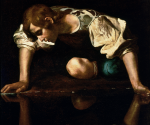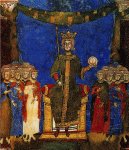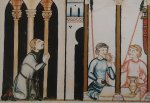Article
-
Fleeing from the profane society: on the obstacles for the construction of authority, rule and the support of the church in the Passio sancti Venceslavi martyris
Andrea Vanina NEYRA
Original title: Huir de la sociedad profana: sobre los obstáculos en la construcción de la autoridad, el gobierno y el fomento de la Iglesia en la Passio sancti Venceslavi martyris
Published in Idea and image of royal power of the monarchies in Ancient and Medieval World
Bishop Gumpold of Mantua’s Passio sancti Venceslavi martyris, commissioned by King Otto II, depicts Wenceslas as a Christian ruler who brought together Christian virtues, ascetic practices along with active political power. This paper outlines the manifest opposition between those features and the characteristics attributed to the people subject to the přemyslid duke’s authority. The population was described as a society of savage people, tied to pagan error and heresy, who imposed significant barriers to the expansion of Christ’s faith in the region of Bohemia. Their incivility, lack of culture and infidelitas are all apparent through the use of certain attributes used to describe the population, its customs and beliefs: impious, delusional, profane, arrogant, inhuman. Thereby, the specificities defining the Bohemian society at the end of the 10th century coincide with Wenceslas’ most important opponent, his brother and fratricide Boleslav. The depiction of the savage, profane and illicit environment is a prefiguration of the final episode of the hagiographical text: the scandalous martyrdom of the future Bohemian patron saint. Similarly, the predestined Christian future of the Kingdom is prefigured in the hero’s early life –a Christian among an erring surrounding– as well as in his miracles.
-
The names of the Moors: the perception of the ethnic-cultural differences of the Islamic populations in a Castilian documentation of the 13th century
Renata VEREZA
Original title: Os nomes dos mouros: a percepção das diferenças étnico-culturais das populações islâmicas em uma documentação castelhana do século XIII
Published in Ramon Llull. Seventh centenary
The present work analyzes how the Muslims are represented, particularly in the Marian songbook produced by Alfonso X of Castile in the second half of the 13th century (“Cantigas de Santa Maria”), in order to verify if the ethnic cultural differences of the Islamic populations, both of the Iberian Peninsula, and from North Africa and the East are reflected in the documentation. In addition, it seeks to ascertain whether it is possible to affirm ignorance on the part of Christians in relation to the internal divisions of the Islamic world, or whether missing information is due to the specific political agenda.
-
The legislative panorama of the territories of the Castile’s Crown in the beginning of the reign of Alfonso X, The Wise
Jaime Estevão dos REIS
Original title: O panorama legislativo dos territórios da Coroa de Castela no início do reinado de Alfonso X, o Sábio
Published in Monastic and Scholastic Philosophy in the Middle Ages
This article has the objective of discussing the effective legislation in the territories of the Castile’s Crown in the beginning of the reign of Alfonso X, The Wise (1252-1284). In the middle of the thirteenth century, the territories belonging to the kingdoms of Castile and León, unified in 1230, by Fernando III (1217-1252), father of Alfonso X, had their own legislation, without a unity among the several juridical codes. In the kingdom of León, as well as in the territories belonging to him, the rights originating from the visigothic Liber Iudiciorum remained. In the territories of the Castile’s kingdom, the old Castilian right was in force, the Fuero Viejo of Castilla, codified in the beginning of the thirteenth century for Alfonso VIII (1158-1214). In the Andalusia territories that were incorporated to the Castilian crown by Fernando III, the Fuero Juzgo ruled, adapted to the local reality. The main task of Alfonso XI in the beginning of his reign was the one of idealizing a project of juridical unification of the several codes on going in the territories of the Castile’s Crown.
-
The "cinocephalus" and the "úlfheðnar": the representation of the wolf-warrior in the Historia Langobardorum (VIII century) and in the Egils saga (c. 1230)
Renan Marques Birro and Jardel Modenesi Fiorio
Original title: Os Cynocephalus e os Úlfheðnar: a representação do guerreiro canídeo na Historia Langobardorum (séc. VIII) e na Egils saga (c. 1230)
Published in The chivalry and the art of war in the Ancient and Medieval World
-
The philosophical contribution to the constitution of the political theory at the end of the XIII century
Francisco Bertelloni
Original title: La contribución de la filosofía a la formación del pensamiento político laico a fines del siglo XIII y comienzos del siglo XIV
Published in Mirabilia 1
This paper deals with the treatment of the philosophia moralis in the Student´s Guide or guidebook of Barcelona as prelude to the Western reception of the aristotelian libri morales.The author analyzes the political consequences of the guide in connection with the methodical separation between philosophy and theology as antecedent of the same distinction in the political theory of the second half of the XIII. century.
-
The victorious life and the disenchanted end of the great Macedonian conqueror Alexander the Great and the novelesque knight Tirant lo Blanc
Anastasia TERZOPOULOU
Original title: La vida victoriosa y el final desencantado del gran conquistador macedonio Alejandro Magno y del caballero novelesco Tirant lo Blanc
Published in Mirabilia Journal
The aim of this article is not to analyze the details of the life of Tirant lo Blanc, a literary figure from the Valencian Golden Age, and Alexander the Great, King of Macedonia, a real historical person of Ancient Greece; but to expose the common features that life presents and, above all, the early, bitter and unexpected end of two great warriors and military strategists.
-
The end of time (or times) as end of the History. A discussion about the mutations of the conception and perception of the Time between the last old period and the coming of the Christianity
Ronaldo AMARAL
Original title: O fim do(s) tempo(s) como o fim da História. Uma discussão sobre as mutações da concepção e percepção do Tempo entre o último período antigo e o advento do Cristianismo
Published in The Time and the Eternity in the Ancient and Medieval World
The mutations/continuities that marked the transition of the old thought for the Christian were multiple and deep, and so much in the ambit of the ideas as of the sensibilities. And here the time. Perhaps for this time conception and perception, resulted of that couple mutations/continuities, giving emphasis here verified them mutations, have been the most significant contribution for the constitution of a new worldview in the breast of the Christian society, since it would impose to the followers no less than the man's own place in the world and of the world in the man, and of both in the ambit of God.
Issue (Mirabilia Ars)
-
Art, beauty and aesthetic contemplation
Organized by Matheus Corassa da SILVA (org.)
Mirabilia Ars 13 (2020/2)

-
Staging the leader's divinity
Images, Texts, Rituals
Organized by Mirko VAGNONI (org.)
Mirabilia Ars 14 (2021/1)

-
The Architecture in Cantigas de Santa María
Organized by José María SALVADOR GONZÁLEZ, Matheus Corassa da SILVA (orgs.)
Mirabilia Ars 06 (2017/1) Special Edition



















































































